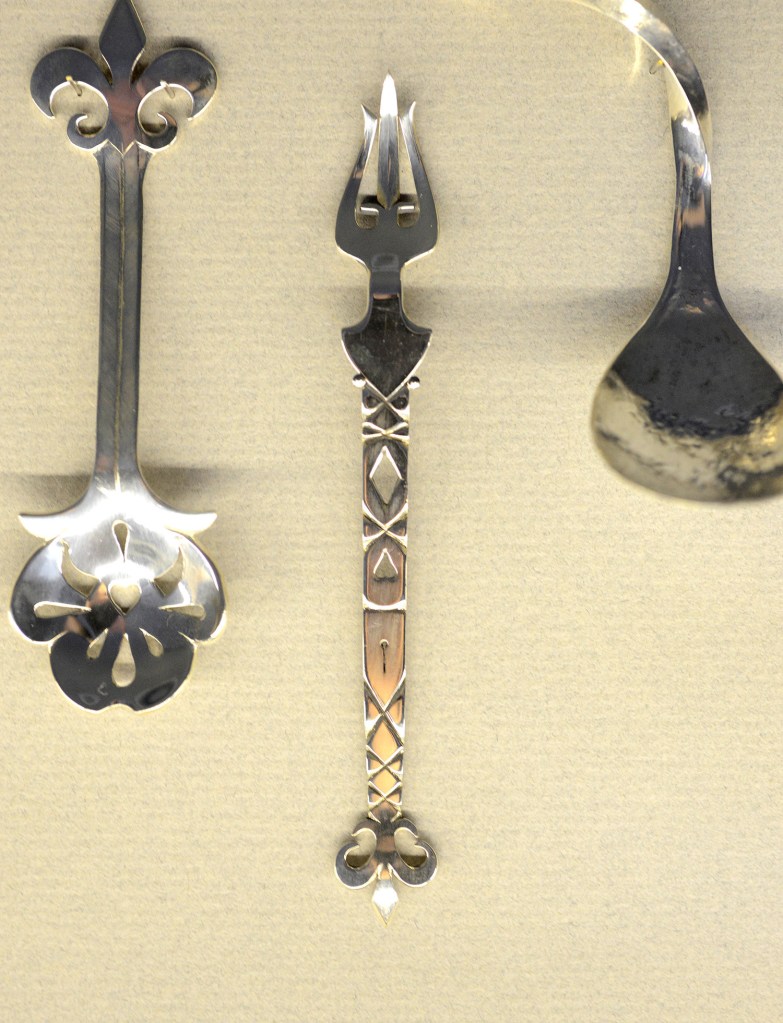Given the pickle revival (thank you, Brooklyn), perhaps it was only a matter of time before somebody revived the pickle fork.
The implement dates back to the 19th century, a time when “mass production and the invention of the electro-plating process made silver forks affordable to a rising middle class who wished to emulate nobility and eat with forks made for specific foods,” Suzanne Von Drachenfel writes in “The Art of the Table.” A partial list of specially designed forks includes those for strawberries, terrapin, sardines, cold meat and ice cream. Yes, ice cream.
And we can thank Portland resident and metalsmith Maria Wolff for “Piercing the Pickle,” a small, surprising group show of quite beautiful pickle forks on display through June 21 at The Bearded Lady’s Jewel Box, on Congress Street. She curated the show, which includes her own work and that of 10 other local metalsmiths, many of them graduates of the Maine College of Art.
The artists, all members of the Metals Collective and all jewelers, mount a group show annually. In years past, they collaborated on a show of absinthe spoons at the Bar of Chocolate, which like The Bearded Lady, is a bar, not a gallery.
“That’s kind of our thing,” Wolff said about the unusual venues and subjects. “That’s why we do this every year – to get us out of our normal everyday work and try to make something out of the box and put it in an out-of-the-box venue. It seems there is a lot of drinking and eating happening in Portland. With that in mind, with Portland more and more on the map for restaurants, for the arts in general, we’re trying to infiltrate that with our metalsmithing.”
Traditionally, pickle forks are long and skinny, designed to reach nimbly into long, skinny pickle jars. Some of the metalsmiths respected that basic design premise. Others interpreted freely, turning pickle forks into jewelry, modifying family silver, making what Wolff called a “conceptual pickle fork.” The artists also expanded on the scope of the show, crafting cocktail picks, oyster forks, pâté knives and relish spoons. Wolff’s own work includes a self-dubbed pickle ax, her fanciful interpretation of Viking metalwork.
That pickle ax, by the way, has already sold, as have some other items, which are mostly made from sterling silver. Prices range from $65 for a pair of modified pickle forks (artist Holly Gooch) to $795 for a forged sterling silver and fossilized (legal) walrus ivory fork (artist Steven Lubecki).
Do ordinary, workaday Mainers with no interest in emulating nobility actually need a pickle fork? “To me it’s more about the ritual of serving,” Wolff said, “and making a beautiful object to use for that instead of using your everyday stainless steel fork laying around in the drawer.”
Wolff used to work at Springer’s Jewelers in Portland, where she saw many a vintage pickle fork. “People melting them down. It was just a heartbreak,” she said. “Some of these beautiful pieces that just aren’t used anymore and people don’t see the value in them.”
Four hundred gallery-goers (or possibly cocktail fans) packed The Bearded Lady’s Jewel Box on the opening night of the show, timed for First Friday in May. They snacked on housemade, artisanal pickles from Home and admired the pickle forks. Given the interest, these pickle forks may have a more promising future.
Send questions/comments to the editors.









